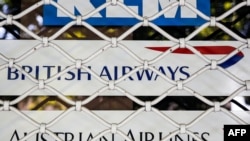Following Washington’s withdrawal from the Joint Comprehensive Plan Of Action (JCPOA), or Tehran’s nuclear deal with world powers, and the renewal of U.S. sanctions, many Western airlines have lined up to leave Iran and suspend their flights to the country. This leaves a vacuum that Arab and Turkish airlines are set to fill.
British Airways, Air France, and its Dutch sibling, KLM, announced on August 23 that they would halt flights to Iran from September for business reasons, months after U.S. President Donald Trump announced he would re-impose sanctions on Tehran.
British Airways (BA) said it was terminating its London to Tehran service "as the operation is currently not commercially viable."
BA, which is owned by Spanish-registered IAG, said its last outbound flight from London to Tehran will be on September 22 and the last inbound flight from Tehran will be the following day.
Air France will stop flights from Paris to Tehran as of September 18 due to "the line's weak [commercial] performance," an airline spokesman said.
"As the number of business customers flying to Iran has fallen, the connection is not profitable anymore," Reuters cited the spokesman as saying.
Nevertheless, there are also political reasons involved in the airlines’ unexpected decision.
Over the past 40 years, the West's relations with Iran have soured, Western airlines were always the first companies to leave Iran and suspend flights to the country.
While Air France, BA, and KLM are record holders for suspending operations in Iran, German Lufthansa has usually been more reluctant to halt its flights to the country.
The number of passengers to and from Iran has dropped significantly since U.S. President Donald Trump’s decision to drop JCPOA and re-impose sanctions on Tehran and the subsequent freefall of the Iranian national currency’s value and raised local departure tax. Most people inside Iran simply can no longer afford to travel abroad.
In the meantime, gloomy international media reports about Iran have discouraged foreign tourists. The current situation is a dramatic shift from just a year ago when Iran, with some 6 million visitors, was enjoying a major tourism boom and record hotel occupancy.
The boom that gained momentum following the implementation of JCPOA in 2016 died down after Washington withdrew from the nuclear deal in May, and numerous Western tours to Iran were canceled.
Since the U.S. withdrawal from JCPOA, many Western companies have significantly cut back back their operations in Iran, putting an end to visits to Iran by their staff and representatives.
However, the commercial reasons for halting flights to Iran does not sound plausible when it comes to many flight routes, including the ones connecting Tehran to Amsterdam, London, and Paris. Even during the worst political turmoil in Iran, these three destinations have always had the most passengers from the West.
Many Iranians living abroad take one of these three routes to travel between Tehran, Europe, and the United States. The freefall of rial’s value against foreign currencies has not affected most of these Iranians, who are payed in dollars, euros, or pounds.
Therefore, one can easily conclude that political reasons rather than commercial ones are behind the move, since airlines such as Air France and KLM, which are members of a unified group, could have avoided halting operations in Iran by combining flights and replacing broad body planes with narrow ones, to compensate for the drop in a number of passengers.
Now, in the absence of BA, Air France, and KLM, it is once expected that Arab and Turkish airlines will step in to fill the vacuum, as happened between 2011 to 2013 when Turkish and Qatar Airlines increased their number of flights to Iran.






